How to get rid of moss on a patio – gardening experts reveal 5 quick and easy methods
Remove moss with these natural or chemical methods


The lovely look of your outdoor seating area can be knocked by natural overgrowth, so how do you get rid of moss on a patio?
Luckily, it's simple, and you have a variety of chemical and natural methods that deliver stellar, and often instant, results.
Here, gardening experts reveal their top backyard cleaning tips to treat moss on a patio and spruce it up for spring and summer hosting.
How to get rid of moss on a patio
When getting rid of moss on patio pavers, bricks or slabs, you need to decide if a chemical method or a natural method is best for you.
Chemical moss removal works quickly but can be damaging to your yard and may be toxic for any pets (or children) in the household. Getting rid of moss naturally, on the other hand, can take a little longer but doesn't pose the same toxicity risk. More often than not, they can also be used to get rid of moss in lawns, too.
To help you decide, our experts have shared their top tricks for both if your patio is going green.
1. Kill moss naturally with vinegar
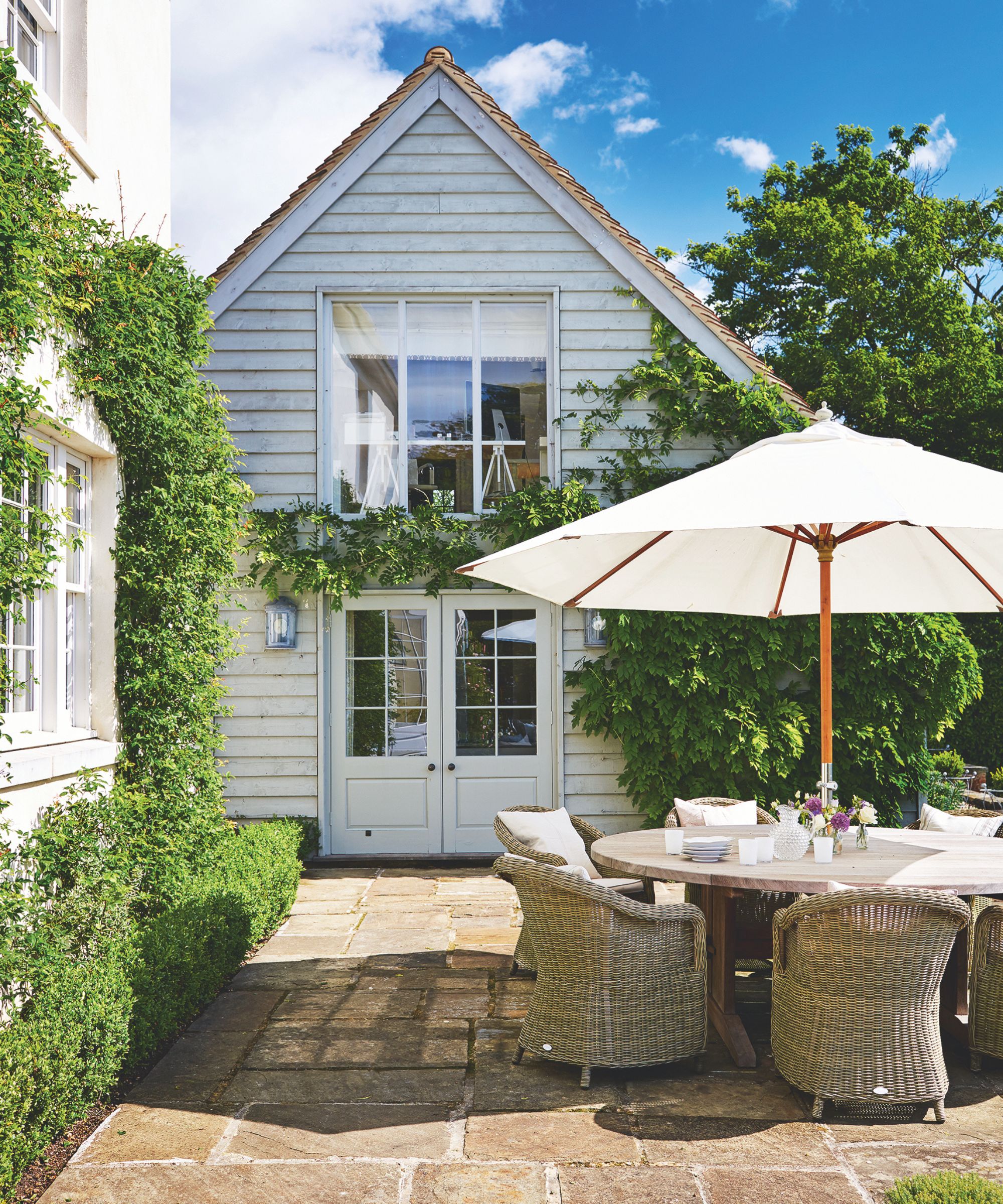
Vinegar is great for freshly established moss patches.
Ryan Harden, gardening expert and owner of The Harden Garden suggests cleaning with vinegar as the first line of defense against moss on a patio.
He says, 'Vinegar kills unhealthy parasites using acetic acid that alters its pH balance without the use of harsh chemicals.
'In a clean spray bottle [available in packs of three at Walmart], combine equal portions of water and vinegar and liberally spray the solution over any mossy patches on your patio. Ensure moist or shaded patches of the patio receive an extra dose. After 24-48 hours pass, scrub with a stiff-bristled brush, from The Home Depot, then rinse with water till clean.
'I recommend trying this method on a dry, sunny day to increase the effectiveness of penetration, drying, and scrubbing.'
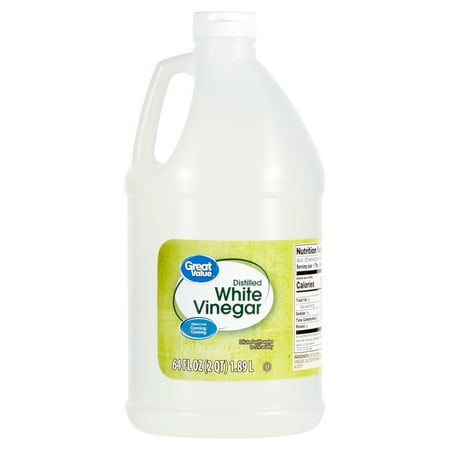
Vinegar is incredibly versatile for household and yard cleaning. It can kill moss and algae outside, while tackling mold and acrid odors indoors. It is a must have for your cleaning closet.
2. Pressure wash

Pressure washing uses no chemicals at all, making it a great eco-friendly option.
One thing people with clean patios always do is power wash regularly. This can help to dislodge moss and remove it without the use of harsh chemicals.
Ryan explains, 'Forceful streams of water remove parasites and spores, ensuring regrowth becomes impossible.
'For the best results when pressure washing a patio, set your pressure washer to low to avoid damaging the surface of your pavers. Maintain one angle and work on small sections at a time gradually.
'Again, this method is best used on a sunny day to allow adequate time for the newly sprayed area to completely dry. This reduces the threat of moss spores re-infesting your freshly clean patio.'
If you do not own one, you can rent equipment such as a pressure washer from The Home Depot or your local cleaning appliance store.
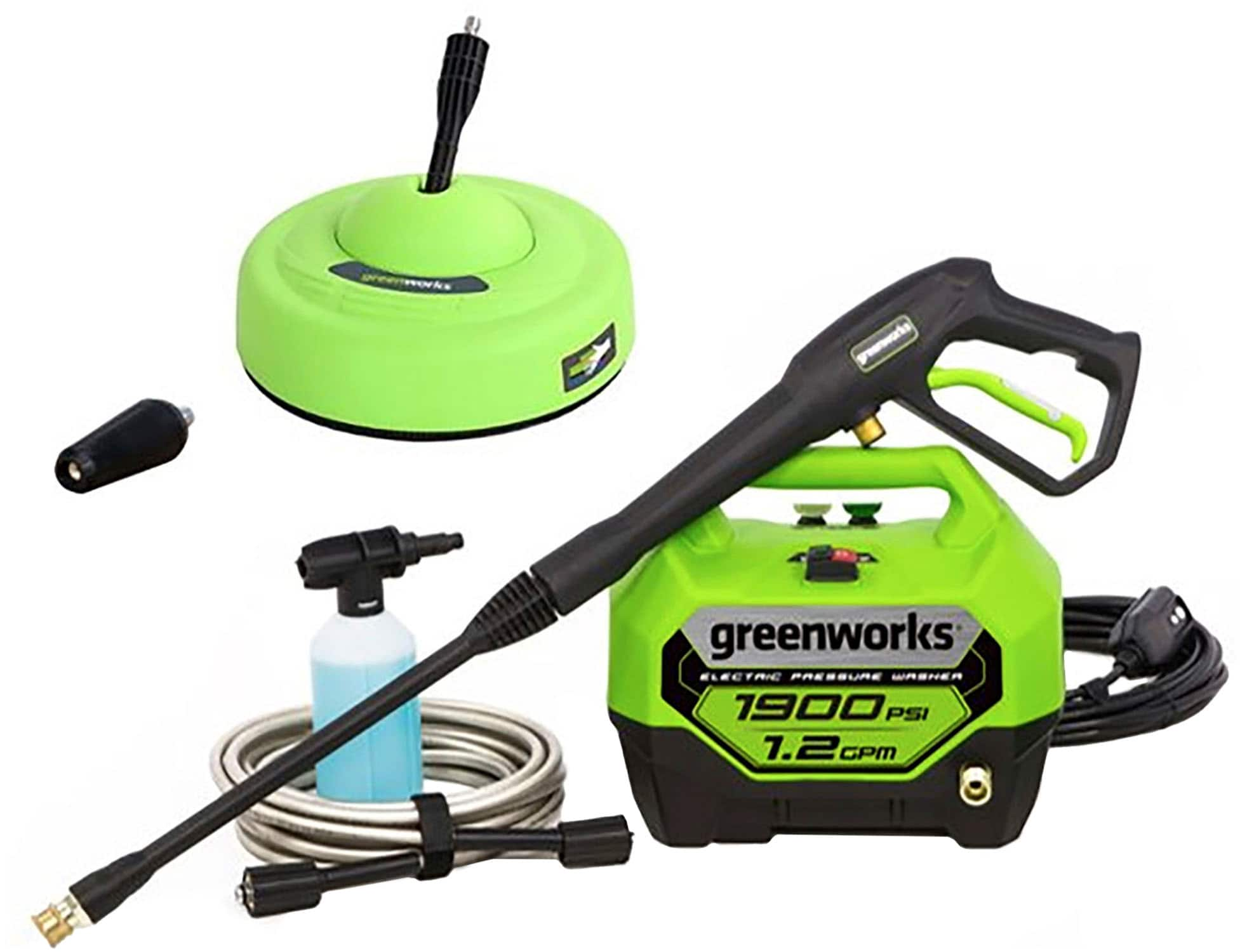
With up to 1,900 PSI at 1.2 GPM, the Greenworks GPW1900 pressure washer is perfect for light or medium-duty clean-up of windows, vehicles, grills, patio furniture and decking.
3. Opt for a commercial spray
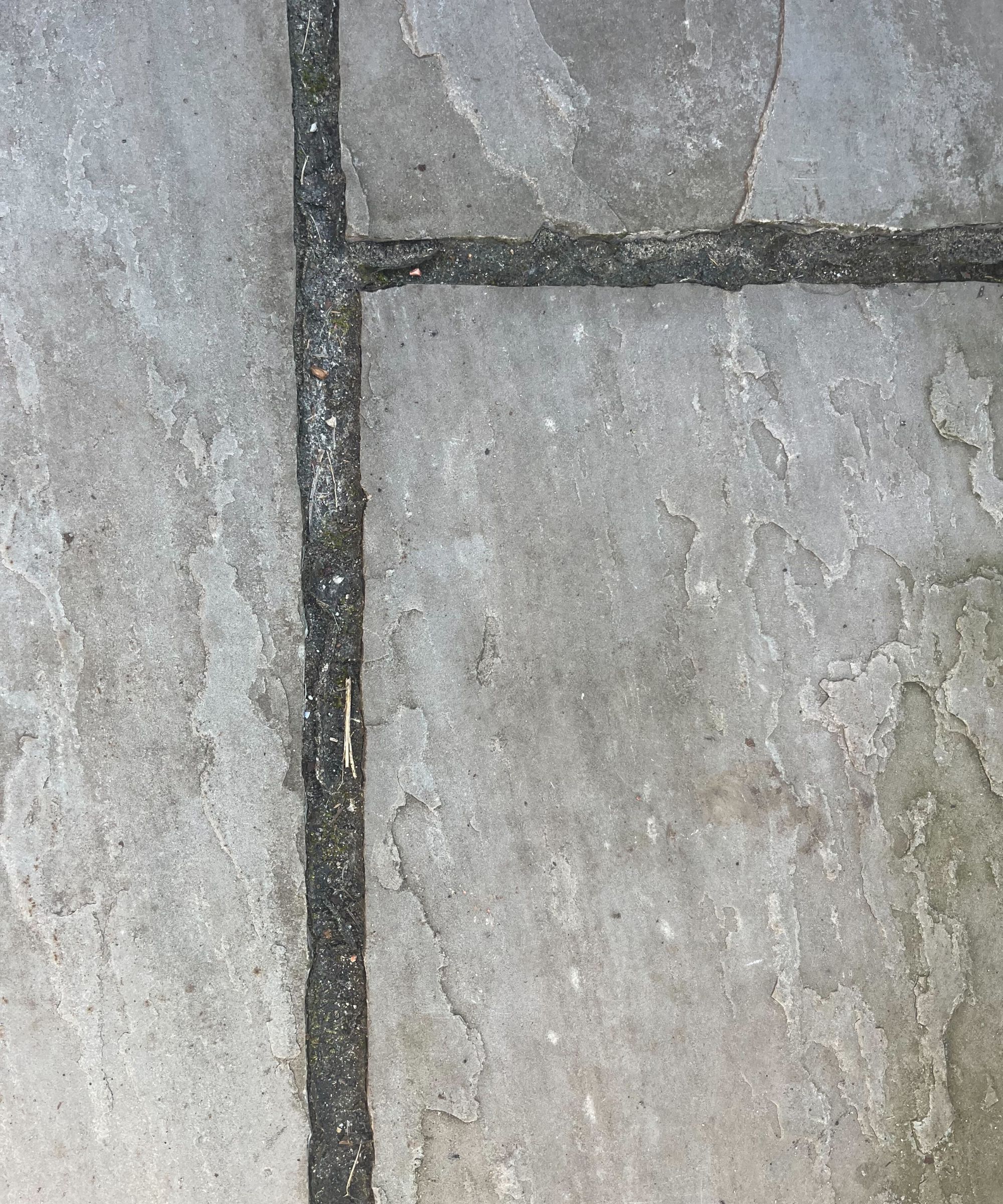
After cleaning
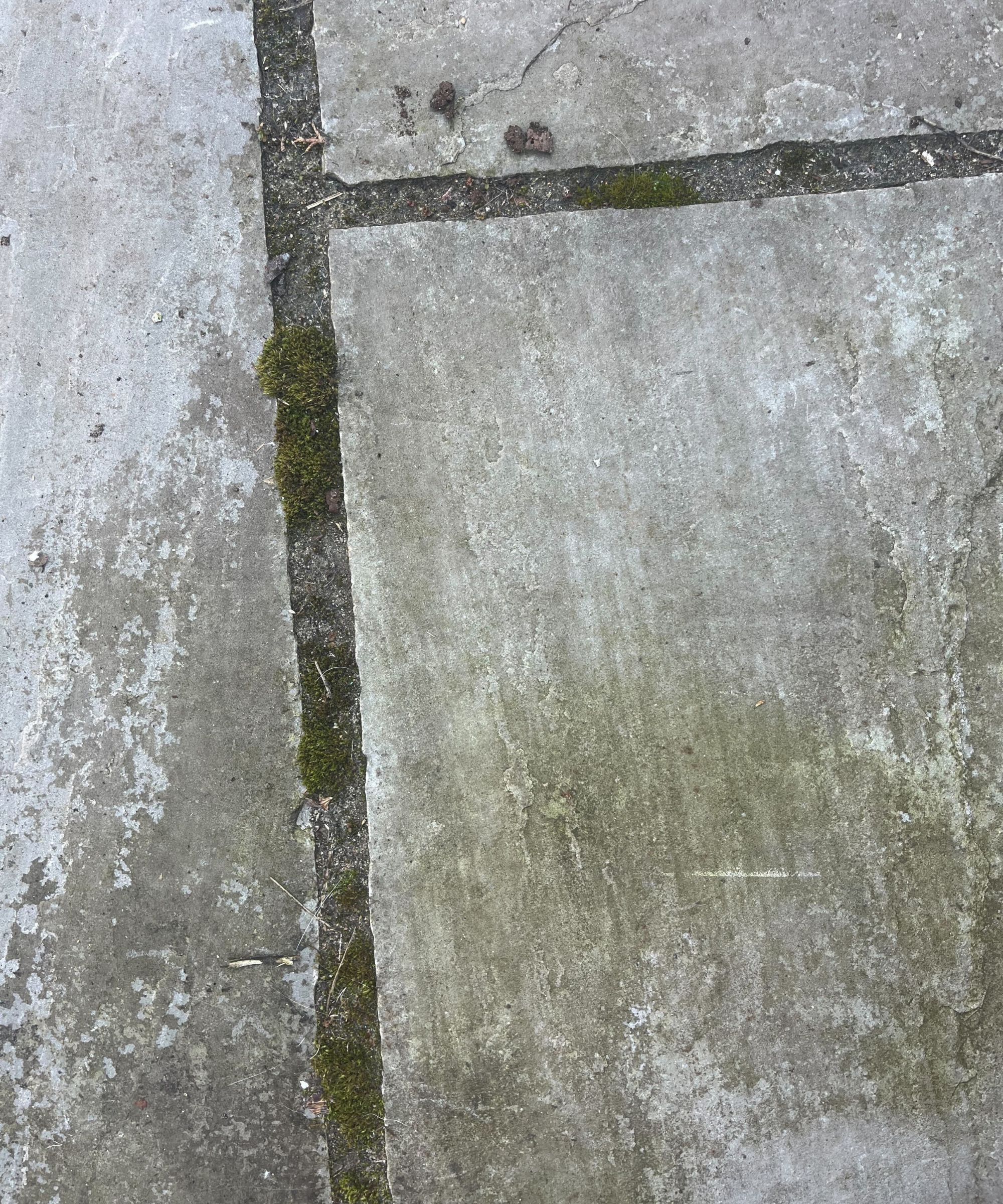
Before cleaning
If you are looking for faster-acting, long-lasting results and don't mind using a gentle chemical spray, Chris Turner, owner and landscape designer at Elevate by Design suggests Wet & Forget Moss, Mold, Mildew & Algae Remover, available at Amazon.
He says, 'This is a solid commercial option. Just spray and let the rain do the work over time.'
I use the Wet & Forget spray on my patio every spring and see long-lasting results time and time again. It mitigates the need to scrub, limits water waste, and is bleach-free, meaning it is better for the environment than other commercial chemicals. Note that it can be damaging to aquatic life, however, so avoid using it near ponds or pouring it down drains.
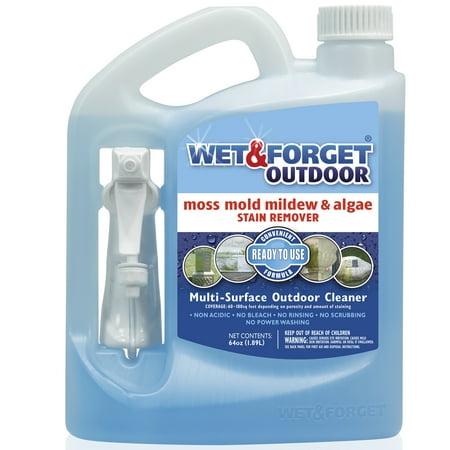
The Wet & Forget spray cleans green and black stains caused by moss, mold, mildew, and algae on a host of outdoor surfaces, including wood decks, furniture, fences, stone walls, patios, and pavers. This bottle comes pre-mixed, so you won't need a sprayer bottle or water to get going.
4. Sprinkle lawn sand
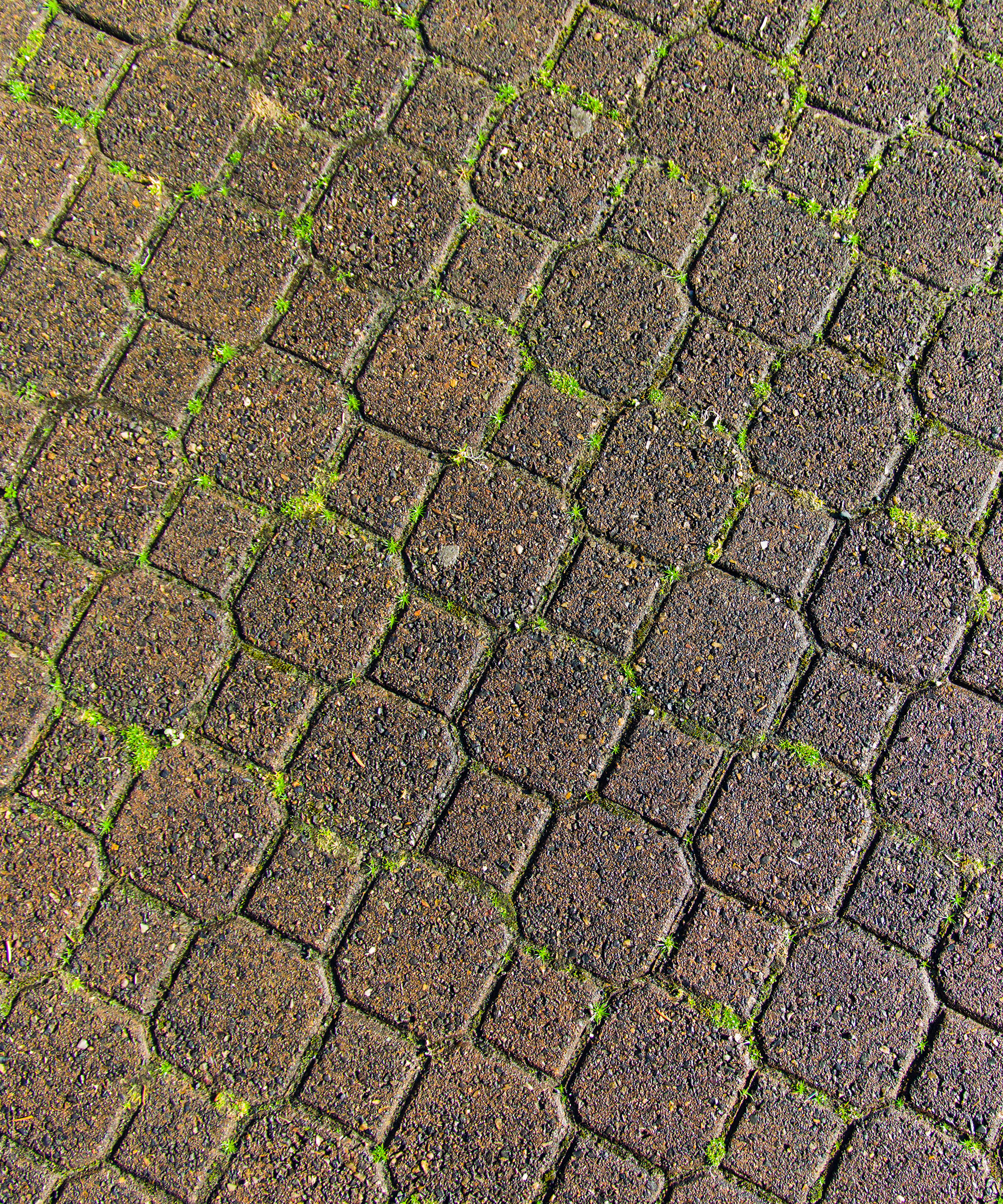
Lawn sand helps to get into the nooks and crannies for even moss coverage.
Lawn Sand, available at Amazon, isn't just sand: it's one part iron sulfate, three parts ammonia sulfate and 20 parts dry sand, and it can be used to kill moss without killing grass bordering the patio.
Sprinkle it on, it will kill moss on patio, and broad leaf weeds too. Once they have turned black you can simply remove them, then sweep or hose off the sand.
5. Diluted bleach
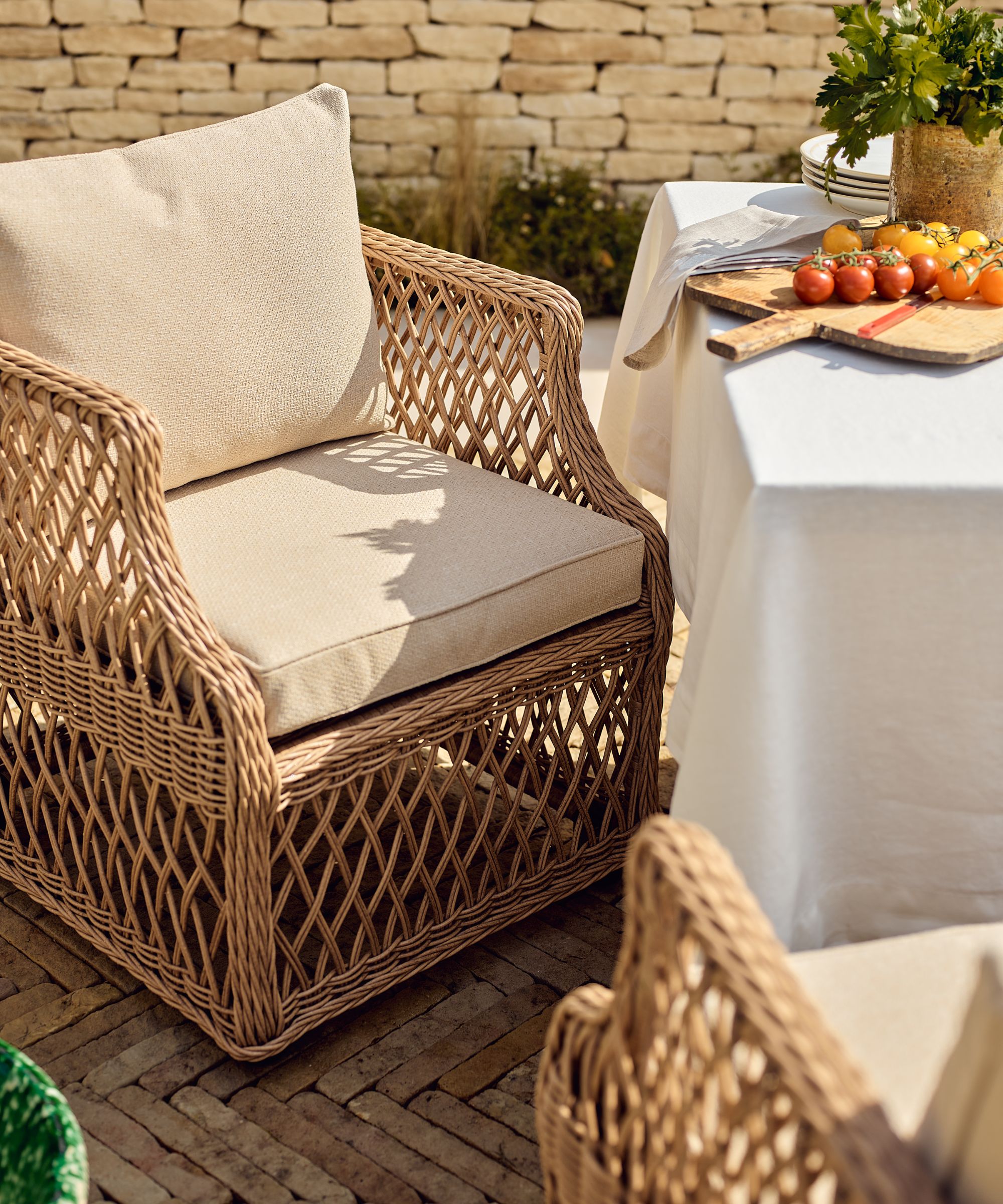
Bleach should be used sparingly to avoid damaging tiles.
Although you generally do not need harsh chemicals to clean well, Rafi Friedman, president at Coastal Luxury Outdoors says, 'For especially stubborn moss, a mild bleach solution will do the trick. Use as little as you can get away with; the bleach may damage your patio or lawn in the area.'
Because bleach is normally one of the many things you shouldn't use when cleaning your patio, using a spray bottle can help you target this treatment to the troublesome moss to prevent damage.
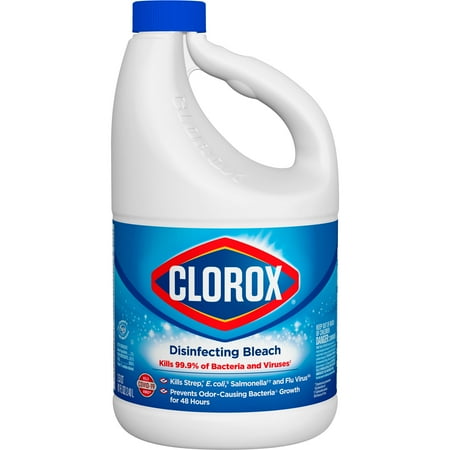
Bleach is an incredibly astringent cleaning chemical which is highly affective against living organisms such as moss. Always use bleach in well-ventilated spaces while wearing gloves to protect your skin from damage.

When decanting bleach into a spray bottle for use against small moss patches, use a funnel to prevent spills that could damage surfaces or your skin.

A glass bottle is better for using with bleach as it limits the risk of plastic warping or contamination, preventing leaks.
How to prevent moss on a patio

Prevention is better than the cure, saving you time and energy while protecting your patio surface.
Preventing moss on a patio comes down to limiting the advantageous growth factors says Chris Turner, 'Moss tends to appear in areas that are shaded, damp, and poorly drained, where moisture lingers and sunlight is limited. '
Therefore, to prevent moss on a patio, you can:
- Improve garden drainage ideas to pull water away from the patio, preventing damp spots.
- Increased sun exposure. Chris suggests 'trimming back overhanging vegetation and sweeping the patio to remove debris cover,' for this.
- Seal the patio surface with a protectant sealant such as BEHR Premium Wet Look Sealer from The Home Depot. Ryan Harden explains, 'A good quality patio sealant, when applied correctly, limits moisture penetration to prevent moss and algae growth.'
- Remove moss as soon as you spot it to limit the spread and prevent it from taking root.
- Clean your patio regularly to remove debris.
Meet the experts
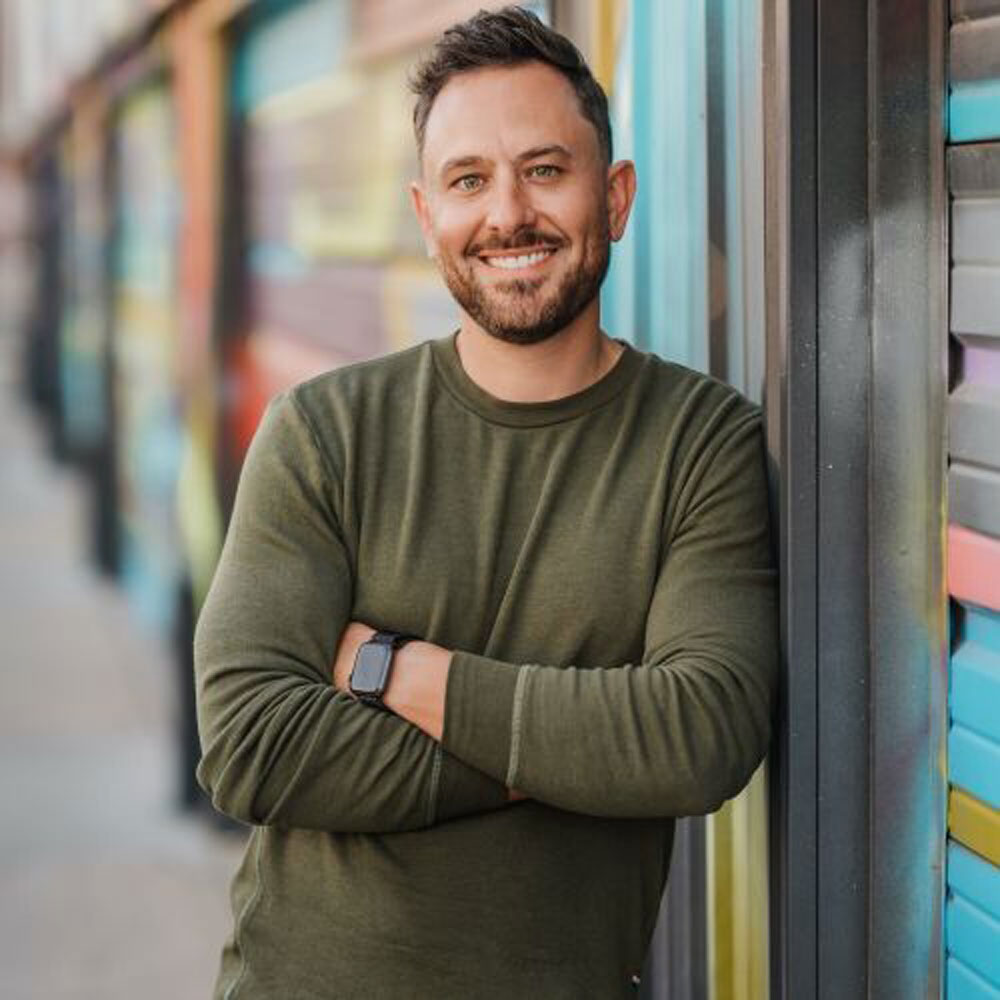
Chris Turner is an expert in designing gardens and outdoor spaces. He is the owner and designer at outdoor architecture practice Studio Nisho. With a keen eye for aesthetics and a passion for crafting outdoor masterpieces, Chris has built a reputation for transforming garden spaces into extraordinary environments.

Since starting The Harden Garden in 2020, Ryan has turned a love for growing into a thriving plant business with a sustainable ethos. He is passionate about encouraging more people to embrace plant ownership, no matter how limited their space.
FAQs
Can you use washing powder to remove moss?
You can use biological washing powder or use dish soap to kill moss by simply sprinkling it liberally over the troublesome area. As with other moss-removal methods, consider the impact on plants nearby, wildlife, and how you will remove the powder remnants from the pavers afterward.
There are simpler remedies, such as removal with a broom or pressure washer, that allow you to simply compost the dead moss.
Does baking soda remove moss from a patio?
Baking soda sprinkled onto wet moss can help to kill small patches of fresh moss, but it is slow-acting and isn't that easy to wash off pavers afterward, so look to better solutions, such as a stiff broom, a pressure washer, moss killer or vinegar.
The good news is that many of the natural moss removal methods for patios can also be used to clean outdoor furniture and remove moss and algae staining, too. Be sure to check the manufacturer guide first, however, and test in a small, inconspicuous spot to avoid lasting staining or damage.
Sign up to the Homes & Gardens newsletter
Design expertise in your inbox – from inspiring decorating ideas and beautiful celebrity homes to practical gardening advice and shopping round-ups.

Chiana has been at Homes & Gardens for two years and is our resident 'queen' of non-toxic living. She spends most of her time producing content for the Solved section of the website, helping readers get the most out of their homes through clever decluttering, cleaning, and tidying tips. She was named one of Fixr's top home improvement journalists in 2024.
You must confirm your public display name before commenting
Please logout and then login again, you will then be prompted to enter your display name.
-
 Plants never to grow next to fruit trees
Plants never to grow next to fruit treesExpert advice on which plants to keep away from fruit trees to encourage a healthy harvest
By Jacky Parker Published
-
 Martha Stewart's tips for arranging daffodils are unbelievably simple and effective – it's the only flower advice you need this springtime
Martha Stewart's tips for arranging daffodils are unbelievably simple and effective – it's the only flower advice you need this springtimeMartha shows us that we can create gorgeous bouquets of this seasonal flower by simply trimming the stems and placing them in specific vases
By Hannah Ziegler Published
-
 5 surprising but brilliant ways to clean with old socks – from perfectly buffing stainless steel to deterring pests naturally and more
5 surprising but brilliant ways to clean with old socks – from perfectly buffing stainless steel to deterring pests naturally and moreTackle dust in tricky corners, clean your mirrors and even banish bad odors with those rogue single socks
By Andy van Terheyden Published
-
 5 things people with clean upholstery always do – simple, quick and oh-so-effective
5 things people with clean upholstery always do – simple, quick and oh-so-effectiveEnsure your furnishing looks clean year-round with these expert tips
By Seraphina Di Mizzurati Published
-
 'Wick away the ick' – 6 things people with clean laundry rooms always do to make this hardworking space shine
'Wick away the ick' – 6 things people with clean laundry rooms always do to make this hardworking space shineThese tips on how to clean your laundry room will banish grime
By Seraphina Di Mizzurati Published
-
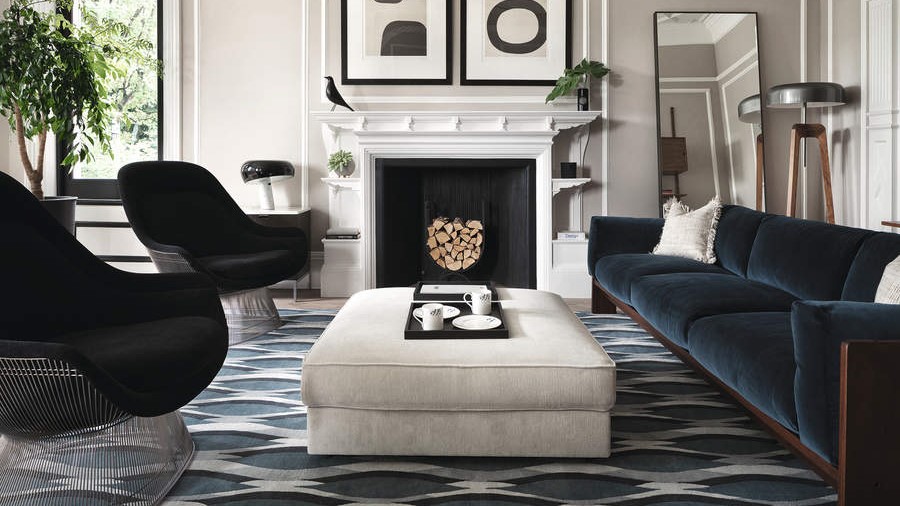 How safe are carpet deodorizers? As a seasoned vacuum tester, I urge you to try alternative methods
How safe are carpet deodorizers? As a seasoned vacuum tester, I urge you to try alternative methodsNatural cleaning is always the answer
By Dan Fauzi Published
-
 'The world will not end' – 5 cleaning habits to quit for a happier, easier life, and what to do instead
'The world will not end' – 5 cleaning habits to quit for a happier, easier life, and what to do insteadGet your home sparkling, minus the stress
By Ciéra Cree Published
-
 9 things you can clean with glycerin – this cheap and natural cleaner is perfect for indoor and outdoor use
9 things you can clean with glycerin – this cheap and natural cleaner is perfect for indoor and outdoor useFrom patio furniture to silverware, this hydrating and gentle cleaning agent will work miracles
By Ciéra Cree Published
-
 How to clean a terrazzo floor in 5 steps – expert tips to scrub, shine, and seal this sparkling floor finish
How to clean a terrazzo floor in 5 steps – expert tips to scrub, shine, and seal this sparkling floor finishAvoid damage and protect it's shine with these expert tricks
By Chiana Dickson Published
-
 I'm 5ft2 and this telescopic scrubber safely and easily banished mold and grime in even the hardest-to-reach areas of my bathroom in less than 15 minutes
I'm 5ft2 and this telescopic scrubber safely and easily banished mold and grime in even the hardest-to-reach areas of my bathroom in less than 15 minutesMy bathroom has never looked better thanks to this handy $16 two-in-one tool from Joseph Joseph
By Ottilie Blackhall Published